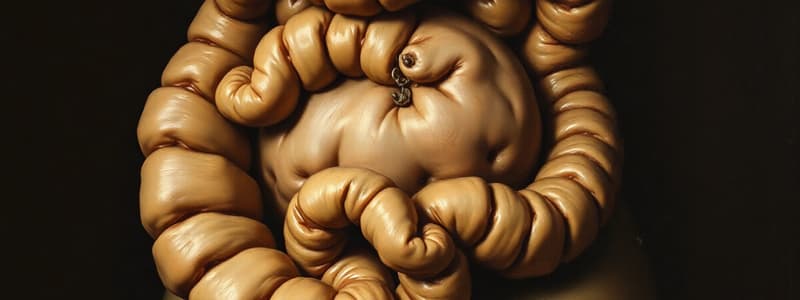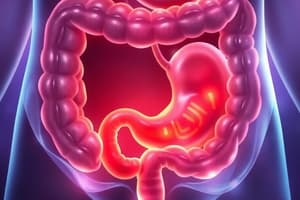Podcast
Questions and Answers
Which of the following is a common cause of mechanical bowel obstruction?
Which of the following is a common cause of mechanical bowel obstruction?
- Cholecystitis
- Appendicitis
- Gastritis
- Hernias (correct)
Scar tissue from previous surgeries can lead to bowel obstruction, also known as what?
Scar tissue from previous surgeries can lead to bowel obstruction, also known as what?
- Fistulas
- Fissures
- Adhesions (correct)
- Ulcers
What is the term for the condition where one part of the intestine folds into another, causing a bowel obstruction?
What is the term for the condition where one part of the intestine folds into another, causing a bowel obstruction?
- Bouveret syndrome
- Volvulus
- Stricture
- Intussusception (correct)
Which test is typically performed before a planned procedure to assess kidney function?
Which test is typically performed before a planned procedure to assess kidney function?
Which of the following tests is essential before a surgery to identify potential bleeding risks?
Which of the following tests is essential before a surgery to identify potential bleeding risks?
Why is an ECG performed before a planned procedure, especially for older patients?
Why is an ECG performed before a planned procedure, especially for older patients?
What structure suspends the testis and epididymis?
What structure suspends the testis and epididymis?
Which of the following is a component of the spermatic cord related to blood supply?
Which of the following is a component of the spermatic cord related to blood supply?
Which of the following is a type of nerve found within the spermatic cord?
Which of the following is a type of nerve found within the spermatic cord?
What is a common electrolyte imbalance observed in acute low bowel obstruction?
What is a common electrolyte imbalance observed in acute low bowel obstruction?
What acid-base disturbance is typically associated with acute bowel obstruction due to vomiting?
What acid-base disturbance is typically associated with acute bowel obstruction due to vomiting?
In acute low bowel obstruction, fluid shifts from which compartment to another?
In acute low bowel obstruction, fluid shifts from which compartment to another?
What is the primary goal of thromboembolism prevention?
What is the primary goal of thromboembolism prevention?
Which of the following is a common pharmacological method for thromboembolism prevention?
Which of the following is a common pharmacological method for thromboembolism prevention?
Besides medication, what mechanical method is used for thromboembolism prevention?
Besides medication, what mechanical method is used for thromboembolism prevention?
Why is early ambulation recommended as a method of thromboembolism prevention?
Why is early ambulation recommended as a method of thromboembolism prevention?
Which of the following is a lifestyle change that helps in thromboembolism prevention?
Which of the following is a lifestyle change that helps in thromboembolism prevention?
What is a potential consequence of a thromboembolism if a blood clot breaks loose and travels through the circulation?
What is a potential consequence of a thromboembolism if a blood clot breaks loose and travels through the circulation?
What is the term for the twisting of the bowel that can cause a mechanical obstruction?
What is the term for the twisting of the bowel that can cause a mechanical obstruction?
Narrowing of the intestinal passage due to inflammation or Crohn's disease is known as?
Narrowing of the intestinal passage due to inflammation or Crohn's disease is known as?
Flashcards
Causes of Mechanical Bowel Obstruction
Causes of Mechanical Bowel Obstruction
Blockage in the bowel caused by stool, hernias, foreign bodies, tumors, volvulus (twisting), adhesions (scar tissue), Bouveret syndrome (gallstone), strictures (narrowing), or intussusception (telescoping).
Pre-Procedure Tests
Pre-Procedure Tests
Urinalysis, liver function tests, complete blood count (CBC), chest X-ray (if indicated), coagulation profile, electrolyte levels, blood typing and crossmatching, blood type tests, and ECG (especially for older patients).
Spermatic Cord Components
Spermatic Cord Components
Testicular artery, cremasteric artery, artery of ductus deferens, SNS fibers, PnNS fibers, genital branch of the genitofemoral nerve, cremasteric fascia, external spermatic fascia, internal spermatic fascia, ductus deferens, pampiniform plexus, and lymphatic vessels.
Electrolyte Disturbances in Low Bowel Obstruction
Electrolyte Disturbances in Low Bowel Obstruction
Signup and view all the flashcards
Thromboembolism Prevention
Thromboembolism Prevention
Signup and view all the flashcards
Study Notes
- Mechanical bowel obstruction is caused by blockages in the intestine.
Causes of Mechanical Bowel Obstruction
- Stool
- Hernias
- Foreign bodies
- Intestinal tumors
- Volvulus (twisting of the bowel)
- Adhesions (scar tissue from previous surgeries)
- Bouveret syndrome (small bowel obstruction due to a gallstone)
- Strictures (narrowing from inflammation, Crohn’s disease, or radiation)
- Intussusception (one part of the intestine folding into another)
Pre-Procedure Tests
- Urinalysis
- Liver function tests
- Complete blood count (CBC)
- Chest X-ray (if indicated for lung assessment)
- Coagulation profile (e.g., PT, PTT, INR, APTT)
- Electrolyte levels (especially Na+, K+, and HCO3-)
- Blood typing and crossmatching (for potential transfusion)
- Blood type tests (to determine the patient's blood type)
- ECG (especially for older patients or those with heart risk factors)
Components of the Spermatic Cord
- The spermatic cord is a soft, round, cable-like structure suspending the testis and epididymis.
- It includes 3 arteries, 3 nerves, 3 fascias, and 3 other things.
Arteries
- Testicular artery
- Cremasteric artery
- Artery of ductus deferens
Nerves
- SNS (sympathetic nervous system) fibers
- PnNS (parasympathetic nervous system) fibers
- Genital branch of the genitofemoral nerve
Fascias
- Cremasteric fascia
- External spermatic fascia
- Internal spermatic fascia
Other Components
- Ductus deferens
- Pampiniform plexus
- Lymphatic vessels
Water and Electrolyte Disturbances in Acute Low Bowel Obstruction
- Acute bowel obstruction is a sudden blockage in the lower part of the large intestine (colon).
- Prevents normal movement of intestinal contents.
- Up to 12 hours: absorption occurs in the proximal bowel, followed by slow progressive malabsorption.
- Production is still preserved.
- After 48 hours: complete blockage of absorption with elevated production of Na+ and K+.
- This is then absorbed into the bowel walls, causing edema.
- Transudate is present in the abdominal cavity.
- Hyponatremia (low sodium) occurs
- Hypochloremia (low chloride) occurs
- Dehydration results from vomiting and reduced absorption.
- Fluid shifts from intracellular to extracellular compartments.
- Metabolic alkalosis stems from loss of stomach acid with vomiting.
Thromboembolism Prevention
- Thromboembolic events are measures taken to reduce the risk of developing venous thromboembolism (including DVT and PE).
- Blood clots formed in the veins become unstable, breaking loose and traveling in the circulation where it can cause blockage.
- Blockage can be life threatening and fatal.
Methods of Prevention
- Anticoagulation therapy (heparin, low molecular weight heparin)
- Mechanical methods like compression stockings or intermittent pneumatic compression devices
- Early ambulation (encouraging the patient to move soon after surgery)
- Prevention of DVT formation and promotion of proper circulation
- Hydration and avoiding prolonged immobility
- Lifestyle changes
Studying That Suits You
Use AI to generate personalized quizzes and flashcards to suit your learning preferences.




